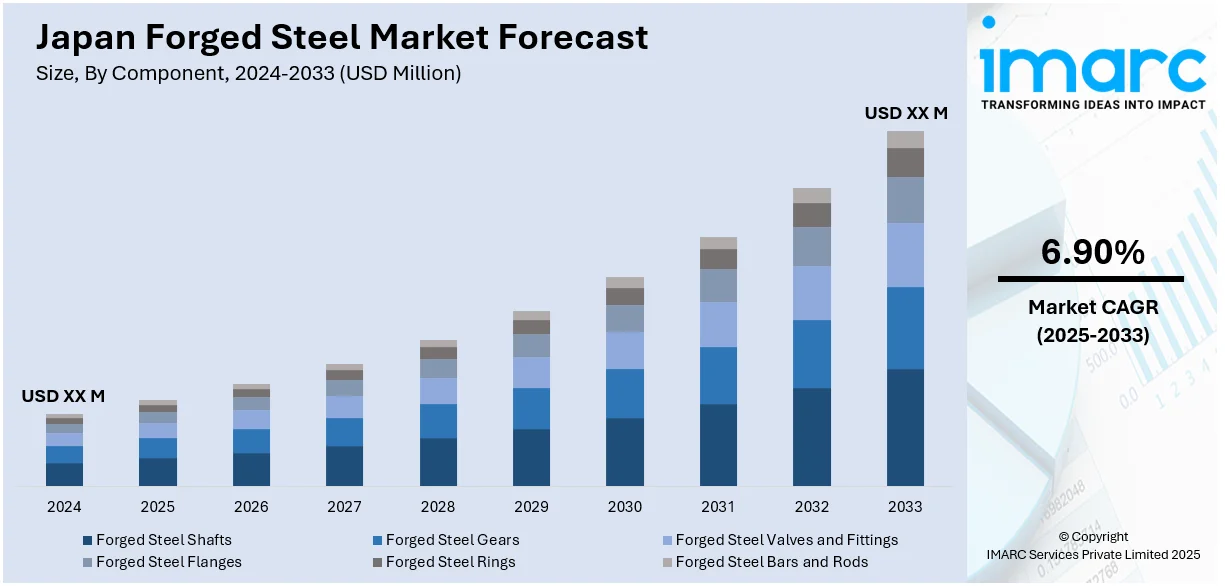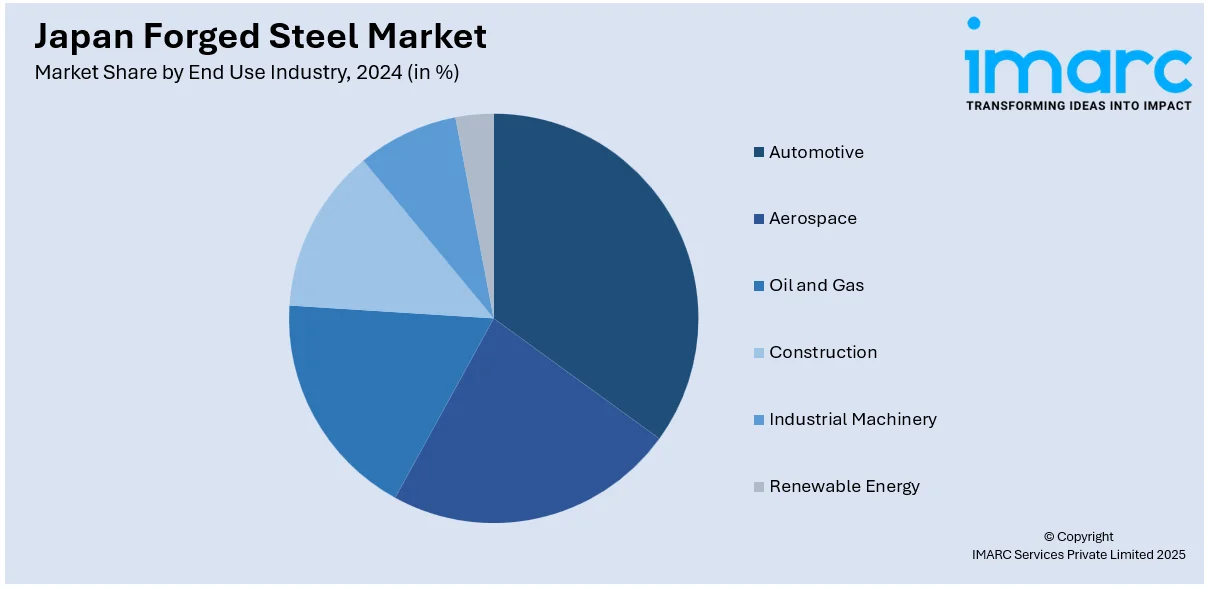
Japan Forged Steel Market Size, Share, Trends and Forecast by Component, Material Type, End Use Industry, and Region, 2025-2033
Japan Forged Steel Market Overview:
The Japan forged steel market size is anticipated to exhibit a growth rate (CAGR) of 6.90% during 2025-2033. The market is dominated by increasing demand in the automotive, aerospace, and heavy machinery sectors. Development of manufacturing technologies and increasing demand for high-quality, lightweight, and long-lasting components shape the Japan forged steel market share.
|
Report Attribute
|
Key Statistics
|
|---|---|
|
Base Year
|
2024
|
|
Forecast Years
|
2025-2033
|
|
Historical Years
|
2019-2024
|
| Market Growth Rate 2025-2033 | 6.90% |
Japan Forged Steel Market Trends:
Increased Demand for High-Performance Automotive Components
Automotive industry in Japan is a major driver for the forged steel market in the country. With the demand for performance cars always growing, high-quality, long-lasting forged steel parts is needed more than ever. This comprises of key components like crankshafts, suspension parts, and gears that need the reliability and strength of forged steel. The growth towards electric vehicles is also creating new avenues in the forged steel industry as they call for specialized components in batteries, motors, and frames. With Japanese automakers more concerned about weight reduction and fuel efficiency, they increasingly depend on new material technology, driving demand for high-performance forged steel products. Improvement in forging technologies is a main driver of Japan forged steel market growth. For instance, in June 2024, Super Screws Pvt Ltd entered into a Memorandum of Understanding (MoU) with Japan's Mitsuchi Corporation to establish a joint venture for the production of cold forged parts in India. This collaboration aims to combine Mitsuchi’s advanced technology with Super Screws’ engineering expertise to manufacture high-quality components for both the Indian market and global exports, with a focus on the automotive and industrial sectors.

Advancements in Forging Technologies and Process Optimization
New technologies like precision forging, isothermal forging, and closed-die forging are optimizing efficiency, quality, and flexibility of manufacturing processes. Such technologies enable producers to create parts with less waste of material, better mechanical properties, and closer tolerances. Automation and robotics in forging processes are also maximizing production efficiency, lowering labor expenses, and enhancing accuracy. As Japan becomes more inclined to embrace these modern technologies, the capacity for producing increasingly complex, high-performance steel parts will grow, solidifying Japan's competitive position in the international forged steel market. For instance, in March 2025, Yamato Kogyo Co., Ltd. and JFE Steel Corporation announced a collaboration in Japan's section steel market. JFE Steel will use Yamato Steel as a supplier for selected H-beam products. The partnership aims to optimize production systems, improve productivity, and meet customer demands, while addressing the structural steel market's challenges. This, in turn, will enhance the efficiency and flexibility of steel production, supporting technological advancements in forging processes.
Japan Forged Steel Market Segmentation:
IMARC Group provides an analysis of the key trends in each segment of the market, along with forecast at the country/regional level for 2025-2033. Our report has categorized the market based on component, material type, and end use industry.
Component Insights:
- Forged Steel Shafts
- Forged Steel Gears
- Forged Steel Valves and Fittings
- Forged Steel Flanges
- Forged Steel Rings
- Forged Steel Bars and Rods
The report has provided a detailed breakup and analysis of the market based on the component. This includes forged steel shafts, forged steel gears, forged steel valves and fittings, forged steel flanges, forged steel rings, and forged steel bars and rods.
Material Type Insights:
- Carbon Steel
- Alloy Steel
- Stainless Steel
A detailed breakup and analysis of the market based on the material type have also been provided in the report. This includes carbon steel, alloy steel, and stainless steel.
End Use Industry Insights:

- Automotive
- Aerospace
- Oil and Gas
- Construction
- Industrial Machinery
- Renewable Energy
The report has provided a detailed breakup and analysis of the market based on the end use industry. This includes automotive, aerospace, oil and gas, construction, industrial machinery, and renewable energy.
Regional Insights:
- Kanto Region
- Kansai/Kinki Region
- Central/Chubu Region
- Kyushu-Okinawa Region
- Tohoku Region
- Chugoku Region
- Hokkaido Region
- Shikoku Region
The report has also provided a comprehensive analysis of all the major regional markets, which include Kanto Region, Kansai/Kinki Region, Central/Chubu Region, Kyushu-Okinawa Region, Tohoku Region, Chugoku Region, Hokkaido Region, and Shikoku Region.
Competitive Landscape:
The market research report has also provided a comprehensive analysis of the competitive landscape. Competitive analysis such as market structure, key player positioning, top winning strategies, competitive dashboard, and company evaluation quadrant has been covered in the report. Also, detailed profiles of all major companies have been provided.
Japan Forged Steel Market News:
- In May 2025, Usha Martin Limited entered into a technical assistance agreement with Japan's Aichi Steel Corporation to enhance operational efficiency and improve steel product quality. This partnership seeks to boost Usha Martin's production of higher-value steel products while expanding its footprint in the passenger vehicle market. Aichi Steel's expertise will play a key role in elevating Usha Martin's manufacturing capabilities.
- In April 2025, JFE Steel Corporation announced a USD 2.2 Billion investment in a new electric arc furnace facility at its West Japan Works, aimed at producing low-carbon, high-function steel. The facility, supported by a government grant, will produce 2 million tons of steel annually and support Japan’s decarbonization efforts by reducing emissions by up to 90%.
Japan Forged Steel Market Report Coverage:
| Report Features | Details |
|---|---|
| Base Year of the Analysis | 2024 |
| Historical Period | 2019-2024 |
| Forecast Period | 2025-2033 |
| Units | Million USD |
| Scope of the Report |
Exploration of Historical Trends and Market Outlook, Industry Catalysts and Challenges, Segment-Wise Historical and Future Market Assessment:
|
| Components Covered | Forged Steel Shafts, Forged Steel Gears, Forged Steel Valves and Fittings, Forged Steel Flanges, Forged Steel Rings, Forged Steel Bars and Rods |
| Material Types Covered | Carbon Steel, Alloy Steel, Stainless Steel |
| End Use Industries Covered | Automotive, Aerospace, Oil and Gas, Construction, Industrial Machinery, Renewable Energy |
| Regions Covered | Kanto Region, Kansai/Kinki Region, Central/Chubu Region, Kyushu-Okinawa Region, Tohoku Region, Chugoku Region, Hokkaido Region, Shikoku Region |
| Customization Scope | 10% Free Customization |
| Post-Sale Analyst Support | 10-12 Weeks |
| Delivery Format | PDF and Excel through Email (We can also provide the editable version of the report in PPT/Word format on special request) |
Key Questions Answered in This Report:
- How has the Japan forged steel market performed so far and how will it perform in the coming years?
- What is the breakup of the Japan forged steel market on the basis of component?
- What is the breakup of the Japan forged steel market on the basis of material type?
- What is the breakup of the Japan forged steel market on the basis of end use industry?
- What is the breakup of the Japan forged steel market on the basis of region?
- What are the various stages in the value chain of the Japan forged steel market?
- What are the key driving factors and challenges in the Japan forged steel market?
- What is the structure of the Japan forged steel market and who are the key players?
- What is the degree of competition in the Japan forged steel market?
Key Benefits for Stakeholders:
- IMARC’s industry report offers a comprehensive quantitative analysis of various market segments, historical and current market trends, market forecasts, and dynamics of the Japan forged steel market from 2019-2033.
- The research report provides the latest information on the market drivers, challenges, and opportunities in the Japan forged steel market.
- Porter's five forces analysis assist stakeholders in assessing the impact of new entrants, competitive rivalry, supplier power, buyer power, and the threat of substitution. It helps stakeholders to analyze the level of competition within the Japan forged steel industry and its attractiveness.
- Competitive landscape allows stakeholders to understand their competitive environment and provides an insight into the current positions of key players in the market.
Need more help?
- Speak to our experienced analysts for insights on the current market scenarios.
- Include additional segments and countries to customize the report as per your requirement.
- Gain an unparalleled competitive advantage in your domain by understanding how to utilize the report and positively impacting your operations and revenue.
- For further assistance, please connect with our analysts.
 Request Customization
Request Customization
 Speak to an Analyst
Speak to an Analyst
 Request Brochure
Request Brochure
 Inquire Before Buying
Inquire Before Buying




.webp)




.webp)












